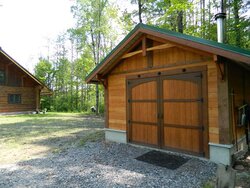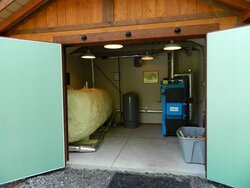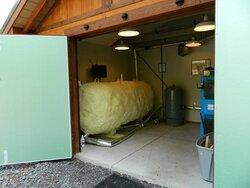Thanks Leon, I 'll need to do a little research as I'm not familiar with an air scoop or airtrol valve. I know a closed pressurized system is more efficient than an open system , but is a low pressure system even more efficient? Would a bladder system of expansion tank ,sufficiently sized, be able work at low pressure and be efficient? Learning more every day. Thanks
------------------------------------------------------------------------------------------------------------------------------------------------------------------------------------------
With my system I barely use 2 bags of coal per day to heat my leaky house using a low pressure system and my house leaks heat like a sieve.
with my steel expansion tank I can have and do have a low operating pressure due to the size of the expansion tank and its 10 gallons of water and 5 gallons of air with low pressure and lower temperature(160 high 140 low).
As I said a 100 gallon expansion tank or for that matter two of them will provide you with plenty of expansion and back pressure to let your circulator run at low pressure. I have one circulator for 2 loops totaling 225 feet and the house is much warmer than when I am using oil heat.
I had a hand fed wood and coal boiler before this and it was just as warm with one circulator.
A closed system is one with either a bladder tank for expansion or a steel expansion tank. A heating system efficiency depends on your heating plant, the heating load, how well the home is constructed and its level of insulation for the home so lets get that out of the way.
You have to decide on whether you want an open system or a closed system. they both work. I hated my sytem when it had an expansion tank as it was not well thought out by the plumber. In their ultimate wisdom/insanity they ripped out a perfectly good open to air expansion tank that hung in the rafters for 30 plus years that had a water level gauge in it and had the hare brained idea that a closed system with a bladder tank was better in 1981-it was not, the system leaked out when my well failed and they had to come out here several times to fill it with water using a jet pump and it was not fun as I had heat and no running water for 7 months because of a lousy well driller.
Its very easy to fill an open or closed system with a steel expansion tank and maintain water levels in the same expansion tank as it has either a sight glass or a gauge glass to check on water levels if you have to change a circulator or have a leak.
With a steel expansion tank in a closed system you fill and let the excess air out of it once and only have to add water back if you have a leak or need to change a pump if its mounted in the wrong place or has no isolation valves. In an open system/ gravity hot water system you have someone watch the water level in the tank in the attic after they bleed the air from the radiators and then its done once the system is filled and the water fill valve is shut.
I grew up with a steam system that had a gas boiler the size of a typewriter table and huge radiators so......................
There are a lot of gravity hot water and steam heating systems that barely grunt in subzero weather to provide heat that lets you live in shirtsleeve comfort.
In floor heating is a waste of money if you have a basement and or an attic that can take full advantage of steam heat or gravity hot water heat in my opinion.
My fathers new home has it and its more trouble than it was worth. the weasels that built the place installed the heating tubing wrong and the tubing did not have reflectors nailed to the underside of the floor boards and the house was freezing until my brother nailed reflective insulation board up to the floor joists.
My fathers wooden floor is also separating in spots and that is not good either.
It does not help that the temperature is 180 all the time and the pressure is to high in my opinion.
People fail to understand that If you have radiators its better to leave them and insulate them on the back side to prevent heat loss and increase the available heat to the room if you do not want to move them to the interior walls where they should be anyway., back then that was not thought of as all we had was rock wool insulation or none at all with good lath and plaster walls.
Please purchase copies of Classic Hydronics and Pumping Away and Dan Holohan explains all this in simple easy to understand terms for the plumber and layperson alike. You will learn a lot about heating when you have read those books. Dealing with fool plumbers is another issue.
You have lots of water mass, take advantage of it by using gravity and simple methods pressure regulating methods that always worked and still work.
A house circulator works just like an irrigation pump, it uses flow at low pressure top move lots of water.
In my system I have the single circulator set at speed 2(17 GPM) and I have no air bubbles and no bleeding to do at all. The pressure from the air charge in the steel expansion tank provides the very low back pressure needed to the 54 gallons of water in the system and as a result low operating pressures and lots of heat at all times.




